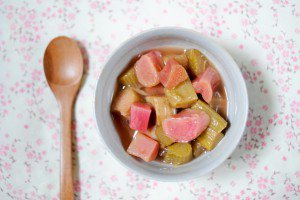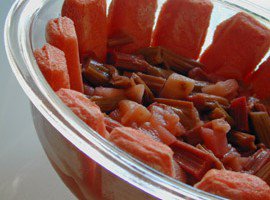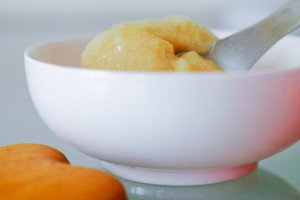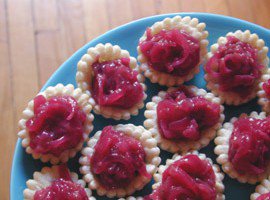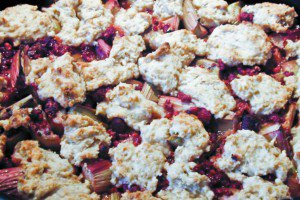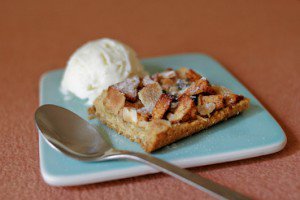I am rhubarb’s most adoring fan.
Throughout the season, in the spring and then in late summer, my weekly market run includes a big bunch of blushing stalks that I’ll cook promptly, once home, into a compote* I’ll eat for breakfast (with a gurgle of homemade kefir) throughout the week.
While compote is my standard use for rhubarb, I love it in a tart, too, and that’s what I decided to serve for dessert last week, when we had friends over for dinner.
My mother makes a fine one on the crisp pâte sablée I’ve shared in my book, with a thin layer of custard filling that is refered to as migaine, goumeau, or not at all, depending on the region. I walked in her footsteps for the most part, straying here and there to try a couple of new things.
In addition to the rhubarb stalks, I had a fresh bunch of lemon verbena that was looking at me with an expression like, “Um, hello?”
First of all, I recently received a copy of Catherine Kluger‘s little book on tarts, and I felt inspired to try her recipe for pâte sucrée (sweet tart dough).
The dough came together easily, and baked into quite the delicate crust, not too rich, not too sweet, and lightly crumbly in texture. I had major difficulties in rolling it out, but the recipe had nothing to do with it: it just happened to be a very warm day — we were going through a mini heatwave that would end in a thunderstorm later that night — and this is a notoriously bad state of affairs if your mission is to roll out pastry.**
Second, I wanted to add a flavoring of some sort to compliment the rhubarb: rhubarb + ginger is the pairing I had in mind originally (in the form of fresh and/or candied ginger, I hadn’t yet decided). But I also had a fresh bunch of lemon verbena on hand that was looking at me with an expression like, “Um, hello?” I didn’t approve of the attitude, but I had to agree their singing voices would harmonize perfectly.
I also applied two tricks I’d picked up while sifting through the comments below this post: 1- I macerated the rhubarb in sugar for a couple of hours so it would release some of its juices. These I reduced into a syrup and then infused with the lemon verbena.
And 2- I sprinkled the bottom of the par-baked crust with a little tapioca, to contain any excess juice from the rhubarb. Unless you’re looking really closely you can’t make them out in the finished product, but it contributes to the silkiness of the filling, and helps the crust retain its crispness. This trick can be applied to any tart in which the fruit might release too much juice during the baking (peaches, for instance) and it’s one I call upon for my savory vegetable tarts as well, though I’ll use orzo pasta (pâtes langue d’oiseau) or bulgur then.
The tart format really is a lovely foil for rhubarb; the best one, I would argue. It’s a humble, comforting dessert — there’s nothing intimidating about the rhubarb tart — that celebrates the complex tang of the fruit***, and in this version, the lemon verbena flavoring subtly accents its floral notes.
~~~
* I enjoy the tartness of rhubarb, so I sweeten my compote very lightly, adding about 10% of the net weight of rhubarb in unrefined cane sugar. I combine the rhubarb chunks with the sugar in my cast-iron cocotte and cook over medium heat for about 15 minutes, stirring once or twice during that time. Then I remove the pot from the heat and let it sit covered for a while to finish softening while we eat lunch.
** When I mentioned this painful situation, Rachel shared the following tip: place an ice-filled tray on your work surface for ten minutes beforehand. It will lower the temperature of the surface (provided it’s not wood) and help keep the dough cool enough to work with.
*** From a botanical perspective, rhubarb is actually a vegetable. Maybe it could switch seats with the fruit-as-a-vegetable eggplant or cucumber or avocado, and then the world would be a less confusing place?

Have you tried this? Share your pics on Instagram!
Please tag your pictures with #cnzrecipes. I'll share my favorites!
Ingredients
- 1 kilo (2 pounds 3 ounces) untrimmed rhubarb, to yield about 800 grams (1 pound 12 ounces) when trimmed
- 80 grams (1/3 cup plus 1 tablespoon) sugar (I use finely ground, blond raw sugar)
- 1 tablespoon uncooked tapioca (or semolina)
- about 12 leaves fresh lemon verbena
- 1 rounded tablespoon crème fraîche or heavy cream
- 1 large egg
- 200 grams (7 ounces, about 1 1/2 cups) pastry flour (in France, use a T45 or a T55)
- 80 grams (1/3 cup plus 1 tablespoon) sugar (I use finely ground, blond raw sugar)
- 25 grams (1/4 cup) almond powder (a.k.a. almond meal)
- 120 grams (8 1/2 tablespoons) cold butter, diced (I use semi-salted; if you use unsalted, add a good pinch of salt), plus a little for the pan
- 1 large egg, beaten
Instructions
- Start about 3 hours before baking. Trim the ends of the rhubarb stalks (no peeling necessary) and slice into 2-cm (3/4-inch) chunks. Place in a nonreactive shallow dish, sprinkle with half of the filling's sugar (40 grams or about 3 tablespoons) and toss to coat. Leave to macerate at room temperature so it will release some of its juices.
- Start about 2 hours before baking. Combine the pastry flour, sugar, almond powder, and salt if using, in the bowl of a food processor or stand mixer. Add the diced cold butter and mix until the mixture takes the consistency of breacrumbs. Add the egg and mix just until the dough starts to come together. (This can also be done by hand, but try to handle the dough as little as you can and without heating the butter too much with your hands.)
- Turn out on a clean work surface. Divide the dough into one 300-gram (10 1/2-ounce) piece and one 180-gram (6 1/3-ounce) piece, and pat each piece of dough into a disk without kneading. Wrap each piece in plastic wrap.
- You'll be using the larger of the two pieces for this tart. Place that one in the fridge and chill for 1 hour. (The other piece can be reserved -- and optionally frozen -- for another use; it is big enough to line a 22-cm [8 2/3-inch] tart pan.)
- Remove the dough from the fridge and let it rest for a few minutes at room temperature so it's not too cold, or it won't roll out well.
- Butter a 28-cm (11-inch) tart pan, preferably one with a removable bottom.
- Roll the dough out on a lightly floured surface and transfer it to the pan to line it, crimping the sides all around with your fingers for a prettier effect. Don't worry if it tears -- just press it back together or patch it up if necessary. Prick the bottom with a fork a few times, and return to the fridge to rest for 30 minutes (this will prevent the dough from shrinking or sliding down the sides of the pan).
- While the crust is chilling, place a medium colander over a bowl and pour the rhubarb and juices through the colander to drain thoroughly. Set the rhubarb chunks aside, and transfer the strained juices to a small saucepan over high heat. Bring to a boil and reduce until you have about 80 ml (1/4 cup) juices. Remove from the heat, add the lemon verbena leaves and let steep.
- Preheat the oven to 170°C (340°F) and insert the pan in the oven to blind-bake (i.e. bake without the filling) for 10 minutes.
- Remove the pan from the oven. Sprinkle the tapioca evenly across the bottom (this will help absorb the rhubarb juices and keep the crust crisp) and arrange the chunks of rhubarb on top in a crowded but single layer. Return to the oven for 20 minutes.
- While the crust and rhubarb are baking, sieve the reduced juices into a bowl to remove the lemon verbena leaves (or just fish them out). Add the remaining sugar from the filling ingredients (40 grams or about 3 tablespoons), the cream, and the egg, and beat to combine.
- Remove the tart from the oven and turn the oven off. Pour the egg mixture evenly over the rhubarb and return to the turned-off but closed oven for another 20 to 30 minutes, for the residual heat to gently set the custard.
- Transfer to a rack and let cool completely before serving.




